Summertime
Grains
|
|
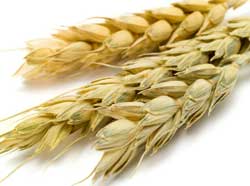 The benefit of
dietary grains does not need to end with bread and breakfast
cereals! The variety of healthy grains that are easily
accessible extends our repertoire of tasty choices.
Grain-based dishes are perfect for cool dining in the
summertime. They are universally appealing, may be made ahead
of time, and only get better as leftovers. The benefit of
dietary grains does not need to end with bread and breakfast
cereals! The variety of healthy grains that are easily
accessible extends our repertoire of tasty choices.
Grain-based dishes are perfect for cool dining in the
summertime. They are universally appealing, may be made ahead
of time, and only get better as leftovers.
We are challenged,
seemingly at every turn, to include more healthy grains into our
diet for the great nutritional benefits - B vitamins, antioxidants,
complex carbohydrates, plant-based protein, and fiber.
The benefits of grains arise from its complex
structure. Grains of most types are comprised of
three parts: the outer hull, the endosperm, and the
germ. Choosing grains with a mix of all three
grain parts creates a wonderful nutritional opportunity. 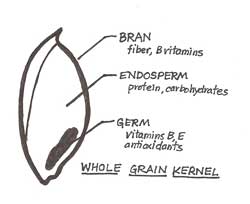
With all due
respect to our local corn-based infrastructure, the most familiar
grain in our culinary culture is wheat. However,
there are other grains, including variations of wheat, worth
experimenting with for hearty, one-dish summer meals:
Quinoa - Of South American origins, this grain is
lauded for its 12-18% protein content, higher than other grain
sources. Unlike other grains, the profile of the protein's amino
acids is complete and in the proportions ideal for human metabolism.
Pronounced "keen'-wah," or "keen-oh-ah," the grain is gluten-free,
and easily digestible.
Couscous - Couscous is a preparation of semolina, a
type of hard wheat. Cracked pieces of the hard
wheat are misted and rolled together forming small, round
pellets. The pellets are coated in finely ground
flour and dried. Couscous is a staple in Mediterranean cultures and
comes in different sizes. In the attached
picture, Lebanese couscous is the largest, Israeli couscous
mid-sized, and "quick-cooking" semolina the smallest.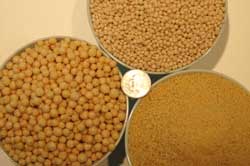
Barley - Similar to wheat, barley is a type of
grass, important to the malted beverage industry, and, as a feed
crop. The outer covering of barley is inedible; thus, it is sold as
"hulled" barley. Hulled barley still has a bran
sheath encasing its endosperm and kernel.
"Pearled" barley is barley with the outer bran removed
through a polishing-like process, hence the term pearled.
Millet - Millet seeds are tiny and round in
character and an available substitute for other grains.
With origins in China and Eastern Asia, millet has been a
valuable food source for thousands of years particularly in dry
climates. Millet is gluten-free.
Bulgur - Bulgur, also spelled bulghur, is cracked
wheat that has been parboiled and dried. (Cracked wheat differs from
bulgur in that it is not pre-cooked). Bulgur is
most commonly thought of as the grain in tabouleh, a parsley, mint,
onion, tomato, and bulgur dish.
Rice - Another grain from the grass family, many
types of rice are available. The shorter the
rice, generally, the stickier it is when cooked. Long-grain rice
works well in grain salads. It's estimated that rice provides more
than 20% of the calories that all humans
ingest! |
Cooking Grains
|
|
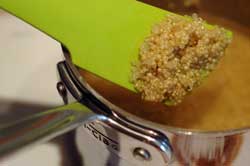 Due to
our unfamiliarity with other culture's grains, and the readily
available "boxed grain kits," it's easy to be a bit intimidated with
how to cook grains from scratch. Grains, such as the above, come in
all forms, whole, cracked, parboiled, and re-formed.
The less processed the grain, the greater the nutritional
value. Due to
our unfamiliarity with other culture's grains, and the readily
available "boxed grain kits," it's easy to be a bit intimidated with
how to cook grains from scratch. Grains, such as the above, come in
all forms, whole, cracked, parboiled, and re-formed.
The less processed the grain, the greater the nutritional
value.
For summer grain
dishes, the kernels should be cooked just until tender, and have a
fluffy character, without any stickiness. To achieve this result,
care must be taken with (a) the ratio of water to grain, and (b)
achieving a low, even temperature. The accompanying chart provides general
guidelines for cooking the various grains.
Cooking
Grains
Grain
Liquid
Time
Quinoa
1
cup
1.75
cups
12-15 minutes
Couscous, Lebanese
12 oz.
6 cups (drain) 25
minutes
Couscous,
Israeli
12
oz.
6 cups (drain) 15
minutes
Couscous,
Quick
1
cup
1.25
cups
5 minutes
Barley,
Pearled
1
cup
3
cups
35-40 minutes
Barley,
Hulled
1
cup
5
cups
60-90 minutes
Millet
1
cup
3
cups
30 minutes
Bulgur (size
variability) 1
cup
2.5
cups
25 minutes
Rice, White,
Long-grain 1
cup
1.5
cups
20 minutes
Rice, Brown,
Long-grain 1
cup
2.5
cups
45 minutes
Another key to
perfectly cooked grains is a good cooking pot and very low
simmering
temperatures. If you haven't
experienced good cookware,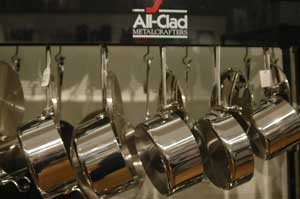 you're
in for a treat! A good cooking pot starts with a heavy-bottom,
sturdy walls, an ergonomic handle, and a well-fitting
lid. The heavy-bottom will conduct heat evenly
across the contact surface and up the walls. A
tight lid will keep the steam inside the pot doing its work on the
grain. We carry several quality lines of
cookware: All-Clad, Viking, Le Creuset,
Chantal, Analon, and Rachael Ray. When you come by the shop, we'd
love to acquaint you with some of the key factors to consider when
buying good cookware. you're
in for a treat! A good cooking pot starts with a heavy-bottom,
sturdy walls, an ergonomic handle, and a well-fitting
lid. The heavy-bottom will conduct heat evenly
across the contact surface and up the walls. A
tight lid will keep the steam inside the pot doing its work on the
grain. We carry several quality lines of
cookware: All-Clad, Viking, Le Creuset,
Chantal, Analon, and Rachael Ray. When you come by the shop, we'd
love to acquaint you with some of the key factors to consider when
buying good cookware.
Beyond these
general starting points, cooking will vary depending on the size of the grain pieces,
the cooking pot, and actual
temperatures. Time the cooking so that you can check the
grain only as it nears its finish. (Too much checking will release too much
steam). With a utensil, check the bottom of the
pan to assess if any grain is sticking.
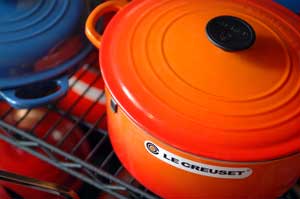 Test
for doneness by testing a few grains from the top.
Ideally, the cooking water should be absorbed just as the
grain reaches the right tenderness. If the grain is cooked, but water remains,
drain the grain in a colander, return to the pan and let it sit 5-10
more minutes with the lid on to
allow any residual moisture to
be absorbed. If the water is gone, but the grain still not tender,
add more water or stock in small increments. Test
for doneness by testing a few grains from the top.
Ideally, the cooking water should be absorbed just as the
grain reaches the right tenderness. If the grain is cooked, but water remains,
drain the grain in a colander, return to the pan and let it sit 5-10
more minutes with the lid on to
allow any residual moisture to
be absorbed. If the water is gone, but the grain still not tender,
add more water or stock in small increments.
Rice cookers may be
used to cook all types of grains. Grains, other
than the quick-cooking type, may be cooked like pasta, in plenty of
water, then drained in a colander. Place the
drained grain back in the warm pot off the burner, replace the lid
and let sit for 5-10 minutes. This method reduces
the chance of scorching, but decreases the nutritional
value. |
Serving Summer
Grains
|
|
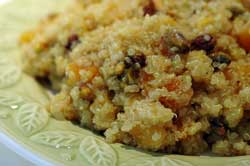 The
presentation of your summer grain dish deserves some
attention. After deciding upon the featured
grain, choose colorful companions. Incorporating
summer's bounty of bright reds, greens, and yellows provides both
visual and taste interest. Consider some of these
combinations: The
presentation of your summer grain dish deserves some
attention. After deciding upon the featured
grain, choose colorful companions. Incorporating
summer's bounty of bright reds, greens, and yellows provides both
visual and taste interest. Consider some of these
combinations:
(1) Quinoa with
Dried Apricots, Pistachios and Orange Citrus Dressing
(2) Couscous with
Lemon, Mint, and Olive Oil
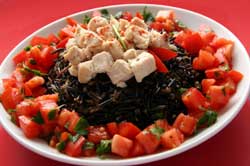 (3) Bulgur with
Broccoli, Scallions, Walnuts, Gorgonzola, and Olive
Oil (3) Bulgur with
Broccoli, Scallions, Walnuts, Gorgonzola, and Olive
Oil
(4) Brown Rice with
Peas, Basil, and a Balsamic Vinagrette
(5) Millet with
Mango, Cashews, Scallions and Curry Seasonings
(6) Bulgur with
Radishes, Cucumber, Dill, and Plain Yogurt (a raita with
grains)
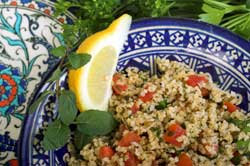 (7) Barley with
Fresh Basil, Pine Nut, Garlic, Parmesan (a non-pureed version of
pesto) (7) Barley with
Fresh Basil, Pine Nut, Garlic, Parmesan (a non-pureed version of
pesto)
Showcase your
one-dish grain meal in a special serving piece.
Large bowls, or platters that compliment the theme add to the
enjoyment of the food. Short of a special serving
dish, a classic all-white, or clear glass highlight the food's
colors.
Serving a one-dish
meal may leave your family asking, "what else is there?"
While satisfaction will quickly be realized, the al
fresco grain dish may be served on a bed of fresh greens, or as
a bed for a grilled meat or vegetable. Complete
the meal with a fresh baguette and your favorite
wine. |
| Plan Ahead Tip |
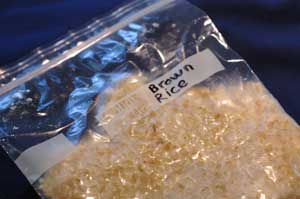 Tip #1:
Double, or triple the
amount of grains that you cook at one time.
Freeze the extra portions in zippered freezer
bags. Arrange the cooled grain in the bag to be
evenly flat. This will allow it to freeze more
quickly, and defrost more quickly. The hot, lengthy step of
preparing the grain is eliminated from your next cold salad
preparation. All of the speed of boxed grain mixes, without the
nutrition loss characteristic of processed "quick-cooking" grain
preparations. Tip #1:
Double, or triple the
amount of grains that you cook at one time.
Freeze the extra portions in zippered freezer
bags. Arrange the cooled grain in the bag to be
evenly flat. This will allow it to freeze more
quickly, and defrost more quickly. The hot, lengthy step of
preparing the grain is eliminated from your next cold salad
preparation. All of the speed of boxed grain mixes, without the
nutrition loss characteristic of processed "quick-cooking" grain
preparations.
Tip
#2: Keep back-up quantities
of chicken stock, or vegetable stock in the freezer, or purchased
varieties in the cupboard. Grains cooked in stock
have a fantastic taste. In most cases, the salt
present in the stock is enough for the grain. If
stock is used, omit adding any additional
salt. |
Q
& A's
|
|

Q: The phone rang, I lost
track of time and the grain in the pan burned while it was
cooking. What do I do now?
A:
There is a fine line between cooking until the liquid is absorbed
and scorching the grain. If a dry bottom has just
occurred, the grain might be salvageable. If
there is no evidence of burning, remove the pan from heat, add 1/4
cup of water to stop the overheating process. If
the grain has stuck to the bottom of the pan, taste the grain at the
top to see if the scorched taste has permeated the pot.
If not, most of the grain may be usable.
If the bottom is clearly burned and the scorched taste
prevalent, start over. The scorched taste cannot
be masked by any amount of dressing. However, you may be eligible to
submit your burned creation to the Burnt Food Museum.
Q:
How can I watch my carbohydrate intake and still enjoy a grain
dish?
A: Grains are an important part of a balanced
diet. Whole grains, with their higher fiber and
protein content compared with refined grains, provide the best in
carbohydrate choices. Double up on the quantity
of vegetables compared to the grain volume; this will reduce the
carbohydrate density.
Q:
I heard that quinoa contains undesirable, bitter-tasting
saponins. True?
A:
Yes, quinoa is naturally covered with a coating of
saponin. The bitter taste, and the mild toxicity
associated with saponin is a deterrent to birds and others that
might otherwise consume quinoa crops. This substance is removed from most
commercially available quinoa in the U.S., and not an issue.
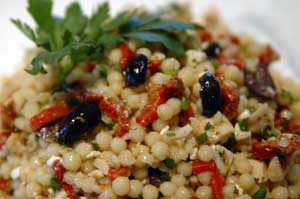
Q:
Is couscous just a different form of pasta?
A: Couscous is similar to pasta in that their
primary ingredient is semolina. Semolina is
coarsely ground durum wheat. Durum wheat is known
as a hard wheat. The round pieces that comprise couscous may be made
with barley or millet, in addition to traditional wheat varieties.
The quick-cooking couscous kits common in local markets are actually
pre-cooked semolina bits, only a "wannabe" to the real
thing. |
| Recipe |
|
The lemon, oregano,
garlic, and olive oil in this salad will immediately transport you
to a seaside café somewhere in the eastern
Mediterranean. These iconic flavors marry well
with a wide variety of grains.
Mediterranean
Salad
12 oz. grain
(Lebanese cous-cous, orzo, bulgur, quinoa, etc.)
1 cup halved,
pitted kalamata olives
1 cup julienned sun-dried tomatoes (packed
in oil, or rehydrated)
1 cup julienned roasted red pepper
4
scallions, thinly sliced, both green and white portions
1/2 cup
chopped flat parsley
2 cloves of garlic, minced
2 lemons,
juiced
2 tsp. dried oregano
2 Tbsp. olive oil (less if the
sun-dried tomatoes are oil-packed)
4 oz. feta cheese, crumbled
(1) Cook the grain
to an al dente stage of tenderness.
(2) Add 1 Tbsp. of the olive to the grain
(to keep it from sticking as it cools).
(3) Cool the grain to
room temperature.
(4) Prepare remaining ingredients.
(5)
Assemble all ingredients in a large bowl. Toss.
(6) Chill and serve. 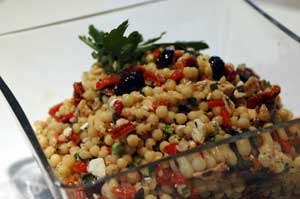
Variations:
(1)
Heat it up - add
1 jalapeno pepper, minced and/or 1/4 tsp. cayenne pepper.
(2)
Heartier - add 12
oz. cooked, sliced chicken breast pieces, or use the salad as a bed
for a grilled chicken breast.
(3)
Intriguing -
combine a couple of grain types for the base of the salad; the
different shapes, color, and texture of the grains create variety
for the eye and the palate. Cook the different grains separately in
order to achieve the right level of tenderness specific to each
grain, then combine while assembling the
salad. | |